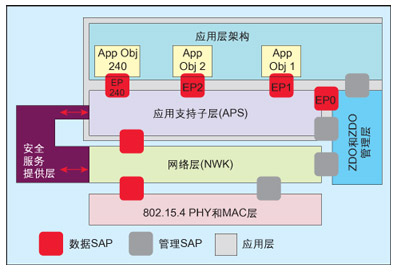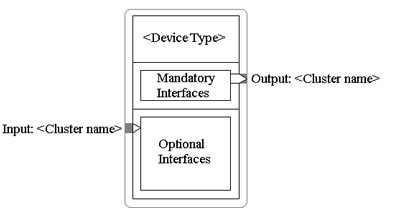 |
Figure 1: ZigBee stack architecture. |
The ZigBee stack is built on the IEEE 802.15.4 standard and defines the MAC and PHY layers of the protocol. The ZigBee device should include the PHY and MAC layers of IEEE 802.15.4 (which defines the RF radio and communication with neighboring devices) and the ZigBee stack layer: Network Layer (NWK), Application Layer, and Security Service Delivery Layer. Figure 1 gives an overview of these components.
ZigBee stack layer
Each ZigBee device is associated with a specific template, which may be a public template or a private template. These templates define the application environment of the device, the device type, and the clusters used for communication between devices. Public templates can ensure interoperability of devices from different vendors in the same application area.
The device is defined by the template and implemented in the form of Application Objects (see figure). Each application object is connected to the rest of the ZigBee stack through an endpoint, which are addressable components in the device.
From an application perspective, the essence of communication is an end-to-end connection (for example, a device with a switch assembly communicates with a remote device with one or more lamp assemblies to illuminate these lights).
Communication between endpoints is achieved through data structures called clusters. These clusters are containers for all the properties needed to share information between application objects. Clusters used in special applications are defined in the template. Figure 2 shows an example of a device and its interface:
Each interface can receive (for input) or send (for output) data in a cluster format. There are two special endpoints, Endpoint 0 and Endpoint 255. Endpoint 0 is used for the configuration and management of the entire ZigBee device. Applications can communicate with other layers of the ZigBee stack through endpoint 0, enabling initialization and configuration of these layers. The object attached to endpoint 0 is called a ZigBee device object (ZD0). Endpoint 255 is used for broadcast to all endpoints. Endpoints 241 to 254 are reserved endpoints.
All endpoints use the services provided by the Application Support Sublayer (APS). APS connects to endpoints through the network layer and security service delivery layer, and provides services for data transfer, security, and binding, thus enabling adaptation to different but compatible devices, such as switches with lights.
APS uses the services provided by the Network Layer (NWK). The NWK is responsible for device-to-device communication and is responsible for the activities contained in the device initialization in the network, message routing, and network discovery. The application layer can configure and access network layer parameters through the ZigBee Device Object (ZD0).
802.15.4 MAC layer
The IEEE 802.15.4 standard defines the first two layers of the OSI model for low-rate wireless personal area networks (LR-WPAN). The PHY layer defines the characteristics that wireless radios should have. It supports two different RF signals, which are located in the 2450 MHz band and the 868/915 MHz band. The 2450MHz RF can provide 250kbps data rate and 16 different channels. In the 868/915 MHz band, 868 MHz supports a channel with a data rate of 20 kbps, and 915 MHz supports 10 channels with a data rate of 40 kbps.
The MAC layer is responsible for single-hop data communication between adjacent devices. It is responsible for establishing synchronization with the network, supporting association and de-association, and MAC layer security: it can provide reliable links between two devices.
About service access points
The different layers of the ZigBee stack communicate with the 802.15.4 MAC through the Service Access Point (SAP). SAP is the interface between the service provided by a particular layer and the upper layer.
 |
Figure 2: Device description defined by the template. |
Most layers of the ZigBee stack have two interfaces: the data entity interface and the management entity interface. The goal of the data entity interface is to provide the required conventional data services to the upper layers. The goal of the management entity interface is to provide the upper layer with a mechanism to access internal layer parameters, configure and manage data.
ZigBee security
The security mechanism is provided by the security service provider layer. However, it is worth noting that the overall security of the system is defined at the template level, which means that the template should define what type of security should be implemented in a particular network.
Each layer (MAC, network, or application layer) can be protected and they can share security keys to reduce storage requirements. The SSP is initialized and configured through ZD0 and requires Advanced Encryption Standard (AES). The ZigBee specification defines the use of a trust center. A trust center is a trusted device that distributes security keys over the network.
ZigBee stack capacity and ZigBee devices
Based on all the features and support provided by the ZigBee stack, it is easy to speculate that the ZigBee stack implementation requires the use of a large amount of memory resources in the device.
However, the ZigBee specification defines three types of devices, each with its own functional requirements: The ZigBee Coordinator is a device that starts and configures the network. The coordinator can maintain a binding table for indirect addressing, support associations, and can also design trust centers and perform other activities. Only one ZigBee coordinator is allowed on a ZigBee network.
A ZigBee router is a device that supports association and can forward messages to other devices. ZigBee mesh or tree network can have multiple ZigBee routers. The ZigBee star network does not support ZigBee routers.
The ZigBee end device can perform its related functions and use the ZigBee network to reach other devices that need to communicate with it. Its memory capacity requirements are minimal.
However, it is important to note that the specific architecture of the network can dramatically affect the resources required for the device. The network topology supported by NWK is star, tree, and mesh. In these types of network topologies, star networks have the lowest requirements for resources.
This article summary
The ZigBee stack should provide all the functionality required by the ZigBee specification, so the manufacturer's priority is to develop practical applications. To make it easier to implement, if the manufacturer uses some kind of public template, then most of the ready-made configurations are available. If there is no suitable public template, you can make full use of the work that other templates have already done to create your own template.
· As a professional manufacture for IPhone Battery ,Huawei Battery,Samsung Battery,and Battery Case for iPhone,Samsung and Huawei more than 8 years,we SHENZHEN HEQUANQINGNUO ELECTRONIC TECHNOLOGY CO.,LTD focuses high quality and full capacity.Samsung Battery Case names also Samsung Charger Case is our 2019 new arrivals products which not only a marvelous phone case cover but also an attractive light and slim Power Bank with large capacity.Instead of taking a heavy but fake capacity power bank,you would be glad to find our Samsung Charge Case is so strong power with 4 indicator to remind you power left timely,you don`t need to worry power lack again when you are engaged in video,movie and games.
Samsung Charger Case
Samsung Charger Case,Quality Samsung Charger Case,Samsung Smart Charger Case,Useful Samsung Charger Case
Shenzhen Hequanqingnuo Electronic Technology Co., Ltd. , https://www.hqqnbattery.com